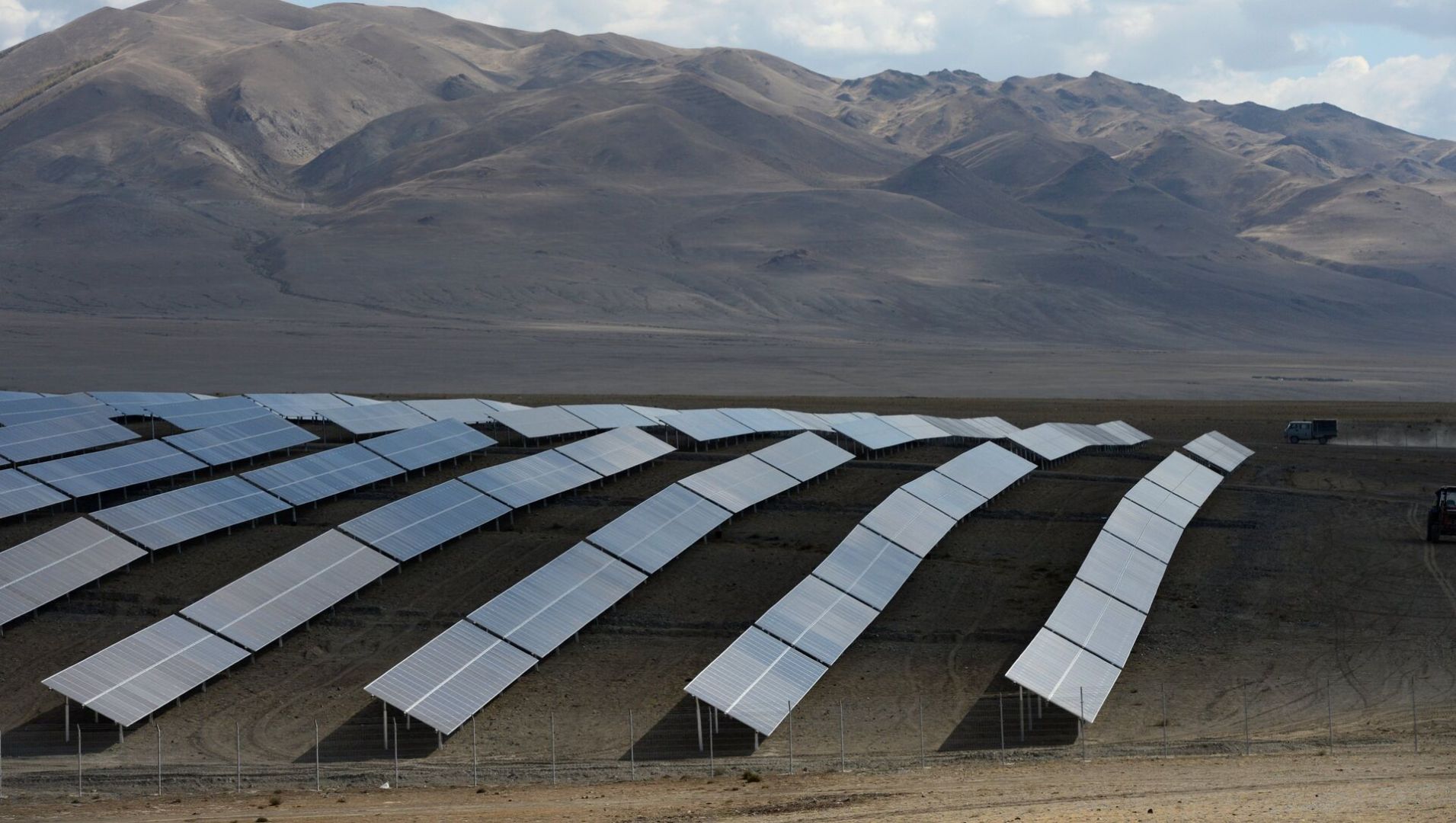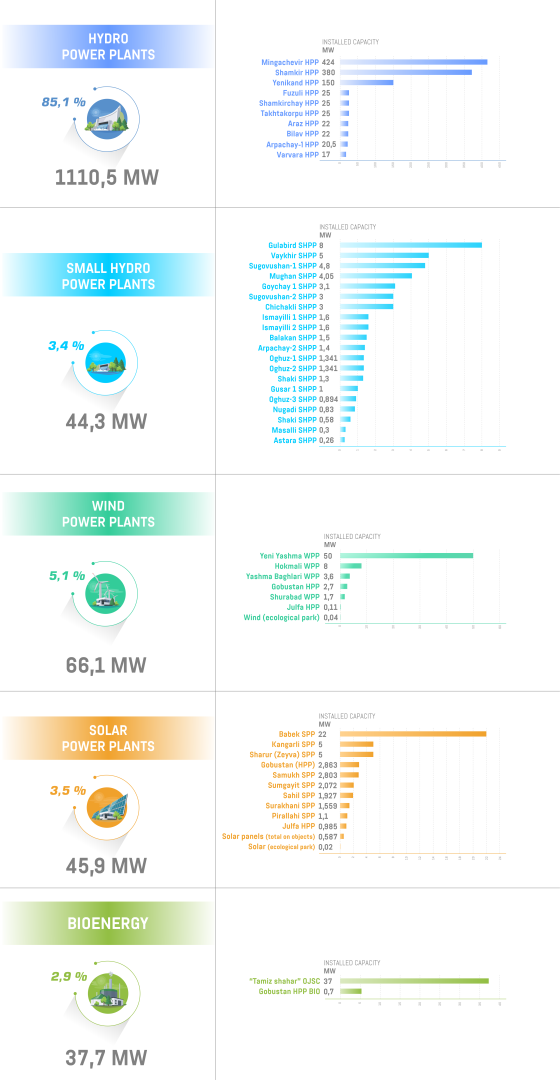Azerbaijan's green aspirations in country's global ecological transition

Being a country with high potential for renewable energy sources, Azerbaijan's overall technical potential renewable energy sources, including onshore and offshore totaled 292GW.
According to the report by Azerbaijan's Economy Ministry, the economic potential of renewable energy sources is estimated at 27 GW, including 3 000 MW of wind energy, 23 000 MW of solar energy, 380 MW of bioenergy potential, 520 MW of mountain rivers. Despite having larger capacity of energy resources and being recognized as an energy exporter in the world, Azerbaijan pays a lot of attention to the use of renewable energy sources. One of the main goals of the energy security policy implemented under the leadership of the President of the Republic of Azerbaijan Ilham Aliyev is to strengthen the use of renewable energy sources in the country.
It is no secret that Azerbaijan's interest in alternative energy is supported at the global level. A World Bank report shows that Azerbaijan can accelerate its green economic transformation to clean energy without emitting gases that affect the ecosystem.
The World Bank supports Azerbaijan's green aspirations in the country's global ecological transition in its ability to overcome a fossil fuel-dependent growth model. Azerbaijan aims for a more environmentally friendly and sustainable economy, in compliance with international rules. Such rules and commitments include the UN's 2030 Agenda for Sustainable Development and commitments under the Paris Agreement on greenhouse gas emissions to meet its Nationally Determined Contributions (NDCs).
"Starting now and with public resources and fossil fuel export revenues, Azerbaijan can chart a new course towards a greener and cleaner future, and the World Bank stands ready to support Azerbaijan along the way," said Sebastian Molineus, World Bank Regional Director for the South Caucasus.
Azerbaijan's clean energy projects include the 230 MW Garadagh Solar Power Plant and Masdar from the Arab Emirates with a signed implementation agreement. According to preliminary estimates, the solar power plant will generate 500 million kWh of electricity annually, save 110 million cubic meters of natural gas per year, prevent 200,000 tonnes of carbon dioxide emissions, and provide electricity to 110,000 homes. The total cost of the project is about $200 million.
The 240 MW Khizi-Absheron wind farm.
The Ministry of Energy of the Republic of Azerbaijan and ACWA
Power of the Kingdom of Saudi Arabia signed an agreement on the
implementation of this project in 2020. The wind power plant
project with a total installed capacity of 240 MW will be
implemented in Sitalchay village of Khizi district and Pirakashkul
village of Absheron district. The wind power plant will generate 1
billion kWh of electricity annually, save 220 million cubic meters
of natural gas per year, prevent the emission of 400,000 tonnes of
carbon dioxide, and provide electricity to 300,000 homes. The total
cost of the project is around $300 million and is expected to be
fully financed by foreign investment.
Construction of a solar power plant in co-operation with BP in
Zangilan and Jabrail district, with a capacity of 240 MW,
Khudafarin, and Giz Galasy HPPs are another opportunity to open a
new way to investment in Karabakh.
According to expert estimates, Azerbaijan will achieve great
results in both production and export of green energy, with import
agreements to countries such as Hungary, Romania, from Azerbaijan,
via Georgia and the Black Sea, and supported by the European Union.
At an initial level, 4 GW of energy is planned to be supplied to
these countries, making Azerbaijan an important supplier of green
energy for Europe.
The total wind energy of the Caspian Sea, which could theoretically
be utilized on the territory of the republic, is estimated at 157
GW, of which up to 35 GW are in shallow water (and therefore do not
require serious financial outlays for utilization) and 122 GW in
the deep water area. Against this background, the Azerbaijani
authorities aim to produce 3 GW of wind and 1 GW of solar energy by
2027, 80 percent of which will be exported, and to create
additional capacity of at least 6 GW of alternative energy.
Green energy zone in Azerbaijan's liberated territories
A green energy zone in the liberated territories of Azerbaijan
emphasizes the construction of energy infrastructure and energy
security as an important part of the reconstruction of the
liberated territories. In line with this objective, 4 rehabilitated
HPPs in Lachin, Kalbajar, and Sugovushan have already been
commissioned as part of the rehabilitation of 20.2 MW of generating
capacity:
HEPP "Gulaberd" - 8 MW;
Sugovushan-1 HPP - 4.8 MW;
MHPP "Sugovushan-2" -3.0 MW;
MHPP "Kalbajar-1" -4,4 MW.
Also, the realization of a wind power plant with an estimated
capacity of 100 MW in Lachin/Kalbajar will make an additional
contribution to the creation of a "Green Energy Zone" in the
liberated territories.
Against this background, the Azerbaijani authorities aim to produce
3 GW of wind and 1 GW of solar energy by 2027, 80% of which will be
exported, as well as to create additional capacity of at least 6 GW
of alternative energy. As the main channel for supplying "green"
electricity to Europe, the Azerbaijani authorities are considering
a project to create a submarine cable 1,100 kilometers long, laid
on the bottom of the Black Sea. Its capacity is estimated at no
less than 1000 MW.
Abbas Ganbay is AzerNews’ staff journalist, follow him on Twitter: @Noend33
---
Follow us on Twitter @AzerNewsAz
Here we are to serve you with news right now. It does not cost much, but worth your attention.
Choose to support open, independent, quality journalism and subscribe on a monthly basis.
By subscribing to our online newspaper, you can have full digital access to all news, analysis, and much more.
You can also follow AzerNEWS on Twitter @AzerNewsAz or Facebook @AzerNewsNewspaper
Thank you!


